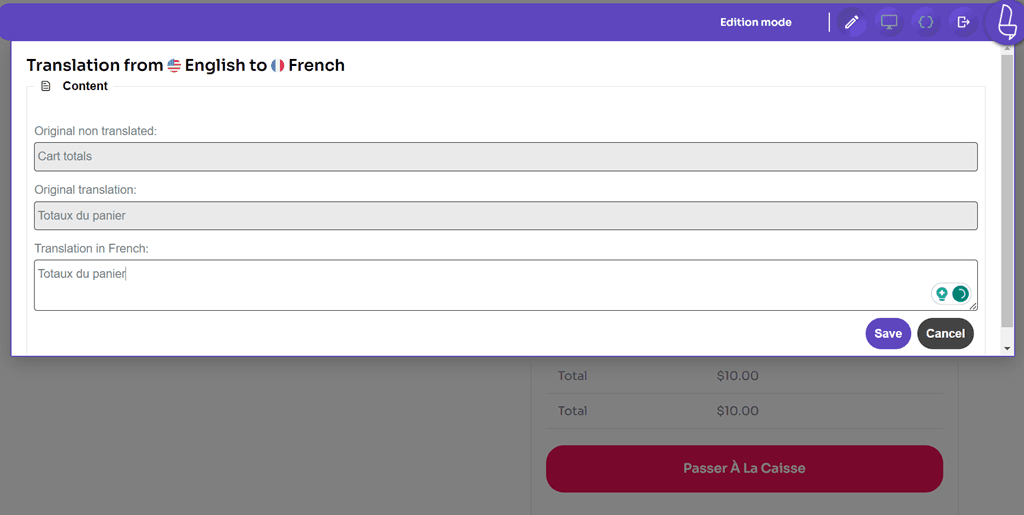Localized and translated website content can help businesses increase product sales conversions. This helps accelerate business growth.
According to a survey conducted by CSA Research in the My Language Connection article, a survey of Fortune 500 companies was conducted, the results being that businesses that invest in translation services have a 1.5 times greater chance of increasing their revenue.
Translation efforts in a business also need to calculate the ROI results, whether your investment in translation has a good impact on the business or not.
In this article, we will discuss in detail starting from what ROI is and how to measure ROI translation.
What’s the ROI?
Return on Investment (ROI), or better known as profit from investment, is a percentage comparison between the amount of net money obtained from a project (its performance) and the amount of money invested in the project.
For example, you spend USD 300,000 to translate your business content. After deducting all related costs, you get a net profit of USD 30,000. At this point, your ROI is “100% x 30,000 / 300,000”, which is equal to 30%. The higher and more positive your ROI, the better.
If the resulting ROI turns out to be negative, it means you are actually spending more money than you are making. This is certainly not a good strategy for long-term business. In the long term, you want to achieve a positive ROI so that your investment is profitable and sustainable.
Why should translation ROI be calculated?
Calculating translation return on investment (ROI) has several important reasons, including the following.
- Justification of costs: Calculating ROI helps improve investment in translation services. By calculating the results obtained and comparing them with the costs incurred, you can demonstrate the value of translation and localization efforts to stakeholders and decision makers.
- Resource allocation: ROI calculation helps to allocate resources effectively. By pulling out the ROI of different translation or language projects, you can prioritize investments and focus on those that provide the highest returns. This ensures maximum use of budget, time and manpower.
- Performance evaluation: ROI provides metrics to illuminate the performance of translation efforts. This allows you to assess the effectiveness of translated content in achieving desired results, such as increased sales, increased customer satisfaction, or wider market reach.
- Decision making: ROI analysis helps make data-driven decisions regarding translation strategies. This allows you to determine whether to continue, expand, or modify translation efforts based on the evaluation results. This data-driven approach reduces haphazard guesswork and increases decision-making accuracy.
- Continuous improvement: Tracking ROI over time allows you to identify trends and patterns. By analyzing the ROI of different translation projects, languages, or target markets, you can identify what needs to be improved and refine your translation strategy for better results.
- Budget optimization: ROI calculations help optimize translation budgets. By understanding which translations generate the highest returns, you can allocate resources appropriately and avoid unnecessary spending on projects that have low impact or low ROI.
- Performance benchmarking: Calculating translation ROI allows comparison with industry standards or competitors. This helps you assess the effectiveness of your translation efforts compared to competitors, identify areas of improvement, and stay competitive.
- Accountability and reporting: ROI analysis provides clear metrics to measure the success of translation initiatives. It increases accountability by quantifying the results and impact of a translation project, which can be reported to stakeholders, clients, or management.
Key metrics for calculating translation ROI
After knowing how important it is to calculate ROI, now we will go into what points you should pay attention to when calculating ROI, here are some of them.
Market research
Conducting market research is an important step in calculating translation ROI. In market research, you can identify opportunities in foreign markets that have potential for your business growth.
Data such as market size, competition, consumer trends and local preferences will help you decide whether your content translation has high return potential. By understanding the market well, you can allocate translation resources more effectively and maximize ROI.
Traffic from foreign markets
The second key point is traffic from foreign markets. Measuring traffic from foreign markets is an important metric for calculating translation ROI. Using web analytics tools, you can track the number of visitors coming from targeted countries.
If translations are successful in attracting visitors from foreign markets, this can be an indication that your translated content is effective in reaching new audiences.
By comparing traffic before and after translation, you can determine its impact on website visits, increased brand awareness and conversion opportunities.
To increase web traffic from foreign markets, the role of multilingual SEO is really needed here. Because, when you have a multilingual website, you also have to optimize the website so that it can be found not only by users in your country, but also in other countries that you are targeting.
Conversion rate on translated websites
Measuring conversion rates on translation websites is also a key factor in calculating translation ROI. Conversions can include a variety of actions, such as purchasing a product, completing a form, or subscribing to a newsletter.
By tracking conversion rates on translated websites, you can broadcast translated content to the extent that it is effective in driving that action from visitors. If you see an increase in conversions after translating a website, this could be an indication that the translation investment is generating positive returns.
For example, the higher the sales conversion rate, the more products sold. This can increase income. This means that investing in multilingual translation is quite effective.
Comparison of translation costs vs revenue generated
The next point is to compare costs, namely translation costs with the income generated. You need to look at the direct costs associated with translation, such as translator fees or translation services, and compare them to the revenue generated after translation.
By comparing these two sides, you can think about whether the translation investment is generating returns that exceed the costs incurred, and whether the translation efforts are financially profitable for your business.
If the translation production costs are greater than the income generated, then a strategy needs to be implemented so that you don’t experience losses.
Unique visitors to that market
By using web analytics tools, you can see how many visitors coming from specific countries or markets translate your content.
The number of unique visitors from a particular market indicates that your translation is successfully attracting local audiences. By aggregating unique visitors from targeted markets, you can measure the effectiveness of your translation efforts in reaching and attracting new visitors.
Translation error rate
If the translation contains a lot of errors or inaccuracies, your content may be difficult to understand or detrimental to your brand image in the target market.
Therefore, by combining translation error rates, whether in terms of grammar, writing, or cultural appropriateness, you can identify areas that need improvement and corrective measures to improve translation quality. Correcting translation errors can be done directly via the front end live editor.
So, you can improve user experience and potential translation ROI.
Downloads/Leads
One of the main metrics used to measure translation ROI is the number of downloads or leads generated after translated content. Some sites often provide ebooks that users can download, or in the case of application marketing, the number of downloads can be an indicator of whether your translation is effective or not.
If a translation manages to significantly increase the number of downloads or leads, this can be considered a positive indicator of translation ROI.
Suppose the target audience reacts positively to the translated content and starts downloading or generating leads in greater numbers. In that case, this shows that the translation is successfully capturing their interest and attention.
By analyzing the increase in downloads or leads after translation, you can assess the positive impact of translation on the popularity and effectiveness of the content in the target market.
Customer feedback
Customer feedback plays an important role in measuring translation ROI. Tracking and providing feedback from customers regarding translations can provide information regarding the extent to which translations are successful in meeting their needs and expectations.
If customer feedback is very positive and shows that the translation has helped improve customer understanding and satisfaction, this can be a good indication of ROI. Additionally, negative feedback should also be taken into account, as it can reveal problems in the translation that need to be fixed.
By understanding customer feedback, you can continuously improve translation quality and ensure that translated content is relevant, useful and meets customer expectations.
Brand credibility
Brand credibility is an important factor in measuring translation ROI. Accurate and consistent translations can contribute to increasing brand credibility in the target market.
When your content is translated well and your brand message remains intact, it can build trust and give an impression of professionalism. Translations that maintain brand messages and values with consistency can strengthen the brand image in the eyes of consumers.
By increasing brand credibility, you can gain long-term benefits, such as higher customer loyalty and differentiation from competitors in the global market.
To ensure your translations are consistent, you may need to use the translation exclusion feature. This feature can ignore content based on text, and exclude pages, or URLs. This way you can include brand names, or technical terms that you want to leave as the original even though they have been translated.
Thats way, readers will get a consistent translation, including the brand name that appears on the content page. So the brand’s credibility will get better.
User interaction with translated elements
When users visit a translated website, it is important to show how they interact with translated elements, such as buttons, links, forms.
Through usage analysis, you can find out to what extent users understand and respond to translated content. If users interact positively and follow the flow desired by your business, this shows that translations are effective in influencing user action and engagement.
By observing user interactions, you can identify which translation elements need to be improved or adjusted to improve user experience and translation ROI results.
Some elements that you should pay attention to include a language switcher to change the language, then if what is translated is an online shop website, pay attention to the checkout, basket, payment pages, see whether the user interaction results there are good or not.
If there are words or content that you are unsure about being translated, you can accommodate the content using the global translation exclusion feature based on text or URL.
Because that is what will determine the user’s decision to buy the product or leave the page.
These are some of the main metrics you need to pay attention to when calculating ROI results.
Best practices for translation ROI optimization
If it turns out that the ROI results are still less than expected, you need to apply the following tips. These tips will guide you so you can produce effective results.
- Set clear goals: Clearly define what you want to achieve with your translation. For example, whether you want to expand your market, increase customer engagement, or improve brand consistency. Clear goals will help you direct your translation efforts effectively.
- Target audience identification: Understand the language preferences, cultural specifics and local needs of your target audience. By understanding your audience well, you can craft a translation that is appropriate and relevant to that audience.
- Align your budget and quality: Align your available budget with your desired translation quality. Don’t compromise on translation quality by significantly cutting your budget, but also reduce the use of resources efficiently to maximize your ROI.
- Prioritize your content: Focus translations on content that has a significant impact and will provide the greatest ROI. Identify the core content that needs to be translated first, such as product or service information, customer support materials, marketing materials, and user interfaces.
- Optimize your translation strategy: consider the use of translation memory, work with professional translators, maintain terminology consistency, and utilize localization tools to improve translation efficiency and quality.
- Compare your results and costs: Make a comparison between the results you get and the costs you spend on translation. Review whether the translation results are worth the investment you have made and refine your strategy if necessary.
- Performance analysis and feedback: Analyze the performance of your translated content, such as website traffic, conversions, customer feedback and user engagement. Use the feedback to improve the quality of the translation and make necessary adjustments.
Translate your website business to increase your ROI with Linguise
Now you know what you need to pay attention to to measure translation ROI and what best practices you can apply. Producing accurate translations for a website is the main thing you must provide.
To provide a website that has been translated into various languages, you can use an automatic website translation service, one of which is Linguise.
Linguise provides perfect translation quality with translation accuracy up to 97% similar to human translation. Apart from that, it also allows businesses to edit existing results with the live editor feature.

This feature makes it easier for users to easily translate results from the front page of the website. To be able to translate a business website with Linguise, you can start by adding a website domain, then install Linguise automatic translation according to the CMS you use such as WordPress or 40 other CMS that are integrated with Linguise.
Apart from that, Linguise also provides an exception translation feature which can make it easier to send translations, based on the following things.
- Ignore text
- Text replacement
- Content exclusion
- Exceptions based on URL
- Ignore inline
Start calculated your translation ROI
At this point, you already know what ROI is and how to measure the translation ROI. By translating a website into multilingual, you can increase the potential for product sales conversions. Translating products into various languages requires website translation services, one of which is Linguise.
To be able to use Linguise to translate websites, you can register Linguise for free account and use the free trial feature for 1 month. With this feature you can translate up to 600 thousand words in 85 language availables.
When you have used Linguise, you can check the ROI, namely the income after deducting costs for translators. This can provide an idea of whether investing in various languages provides benefits to your business.




